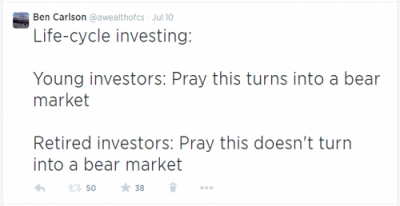“My interest is in the future because I am going to spend the rest of my life there.” – Charles Kettering
Are you bullish or bearish on the market? I get this question a lot.
Obviously I have my feelings on the attractiveness of the different stock markets. But in the grand scheme of things, how I think about being bullish or bearish has a lot to do with my personal time frame. That’s why it’s one of those questions that is impossible to answer without knowing a ton of information about the individual that’s asking.
Here’s a tweet I sent out last week to shed some more perspective on this topic:

Saying stocks are risky investments is completely context and time horizon dependent. If you are a retiree you have different worries and objectives than someone just starting out in their career. Your portfolio construction should account for this fact.
Life-cycle investing means that any market scenario will have different implications to different groups of investors. If you still have many years to save and invest you should actually welcome market volatility. If you will be spending down your portfolio volatility can be painful.
Unless you’re a pundit or fund manager you don’t have to view the markets in terms of bullishness or bearishness, just like it’s not your job to beat the market or a certain benchmark. Think about your portfolio and the markets in terms of where you are in your life right now and where you would like to be. These things should matter much more than how you feel about stocks right now.
Your portfolio should reflect what it is you want to get out of it. Everyone has different goals that they are saving and investing for – retirement, vacations, a down payment for a house, weddings, college for your children, etc.
While it makes sense to view your entire portfolio in aggregate for asset allocation and performance monitoring purposes you should really think about it in terms of multiple time horizons. A portfolio is really just a stream of assets to meet your future liabilities.
Here are some examples:
Stocks: Help you stay ahead of inflation and provide for spending needs that are far out into the future.
High Quality Bonds: Provide income and stability along with the potential for dry powder to rebalance during economic and stock market downturns.
Sub-Strategies & Portfolio Tilts: Diversification to help during the bumpier investment cycles and rebalance to provide a smoother ride.
Cash (Savings): Protects from permanent loss of capital to use in short-term situations for emergency savings and spending purposes.
Human Capital (Future Income): Your future pool of savings to be able to add to your portfolio over time.
Age and time horizon aren’t your only determining factors for portfolio construction. You also have to think about:
- How much risk do you have to take to hit your performance target?
- What is your lifestyle inflation?
- Is your portfolio mature or will you be making substantial contributions for a number of years?
- How much of your portfolio will be required for spending needs in the near future?
- How much can you afford to lose in the short-term and still be on track over the long-term?
- Does your portfolio mix match your willingness and ability to take risk?
It’s difficult to precisely quantify these questions into a perfect portfolio, but that’s investing. It’s about creating a system within a plan that gives you the highest probability for long-term success to reach your needs and desires.
Try not to think of the markets in terms of bullish or bearish, but better or worse for your own personal situation.

[…] Bull or Bear […]
[…] Saying you are “bullish or bearish” is pretty much meaningless. (A Wealth of Common Sense) […]
Does it say something that I read the title as “Are you Bull$hit or Bearish?” Haha…
That would have been the more attention grabbing headline. I’ll save that one for my how to piss people off post.